
|   |

|   |
Kathakís date with Academia- Mumbaiís first Kathak Symposium - Devesh Mirchandani August 27, 2016 Kathak has been an integral part of Mumbaiís cultural scene, starting with Madame Menaka in the 1930s, who went on to travel the world as well as feature in many Indian and international movies. This was followed by late stalwarts Damayanti Joshi, Natraj Gopi Krishna, Lacchu Maharaj, Sitara Devi and later Reba Vidhyarthi, Madhurita Sarang and Asha Jogelekar, all of whom lived in Mumbai and made Kathak well known worldwide as well as left an everlasting impression in Bollywood through movies like Mughal e Azam, Pakeezah, Jhanak Jhanak Paayal Baaje and many such iconic movies. Recently, movies like Devdas and Bajirao Mastani saw maestro Pt Birju Maharaj direct Madhuri Dixit and Deepika Padukone into beautiful dancing visions. Mumbai being a multicultural city, the practitioners of art in this city are always influenced by the latest trends in fashion, art sensibility and international influences. Thus Kathak in Mumbai developed its own flavour. The Mumbai Kathak Symposium organized and curated by Kathak exponent Ranjana Phadke, is the first time in this almost 100 years history of Kathak in this city, that 4 generations of Kathak artists came together on one platform to look at Mumbaiís Kathak history not only from an academic perspective but also from creative perspective covering every topic related to this classical form of dance. Held at IIT, Powai on 21 Aug 2016, the connoisseurs consolidated under one roof to look at the science hidden behind this art. 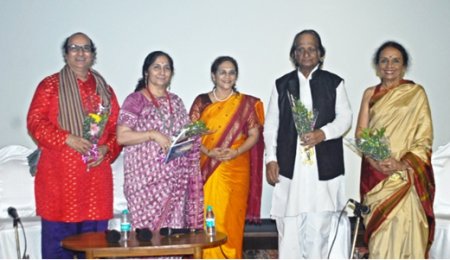 L-R: Dr. Rajkumar Ketkar, Uma Dogra, Ranjana Phadke, Guru Ganesh Hiralal and Sunayana Hazarilal The symposium began with Guru Sunayana Hazarilal, Guru Ganesh Hiralal, Dr. Rajkumar Ketkar and Uma Dogra sharing about how Kathak and its training process has evolved since their time. Sunayana especially highlighted the shift of Kathak from a solo art form to a group presentation. Hiralal requested all assembled dancers/ teachers that they should be supportive of each otherís students so that the future generation can go forth in a positive environment of artistic exchange. This was followed by an intense and emotionally charged session where Jayanti Mala Mishra (daughter of Sitara Devi), Keka Sinha (student of Reba Vidhyarthi), Moli Siddharth Das (student of Damayanti Joshi) and Paulomi Mukherjee (student of Ramadevi Lacchu Maharaj) shared their learning experience under their gurus, their teaching techniques, methods that not only made them better dancers but enhanced their persona and shaped them into better people, akin to how a mother nurtures her child. Renu Sharma who has trained under Lucknow stalwarts Virakam Singhe, Lacchu Maharaj and Birju Maharaj, said that sometimes in class when she teaches the repertoire that she learnt as a child, she can feel a different energy flowing through her making her almost nostalgic and these special moments make all the hard work rewarding. Jayanti Mala said that in todayís day and age, every student who comes forth to learn a classical dance form is not only special but courageous because itís an onerous path chosen by the pupil and she applauds them all. Moli Siddharth Das and Keka Sinha shared how for almost six years their guru taught them the same thing every day, as a result they have been able to achieve perfection in their craft. Unfortunately in todayís day and time, this is not possible as students have time constrains, educational burden, unmatchable competition, parental and peer pressure and many other commitments to fulfil. Paulomi shared an incident how Ramadevi had send her to the zoo for a whole day to go observe ducks (badak) so that she can learn their gait (chaal), which she later used in the Ďbadak ki chaal.í That was the kind of training those days and the expectations were colossal which alas cannot be possible in todayís time. Not to mention the students were genuinely assiduous and fixated to excel. 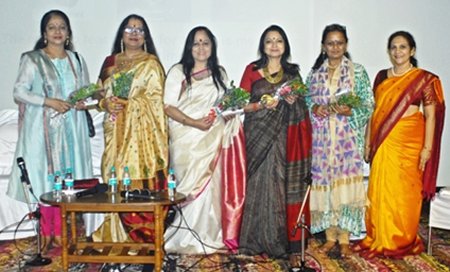 L-R: Renu Sharma, Moli Siddharth Das, Jayanti Mala Mishra, Keka Sinha, Paulomi Mukherji, Ranjana Phadke 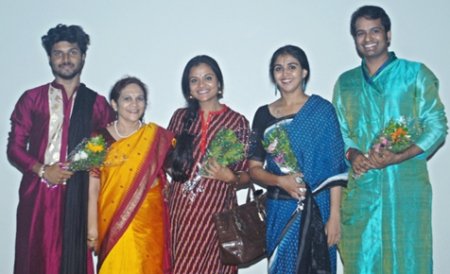 L-R: Ayan Banerjee, Ranjana Phadke, Aditi Bhagwat, Sanjukta Wagh, Sunil Sunkara A discussion on the interplay of craft and narrative was lead by Aditi Bhagwat, where Sanjukta Wagh shared with Kathak students the kind of questions she asks herself and how those answers help her choreograph. By giving an impromptu performance on an English poetry that she set to a khand jaati (5 beat), she translated this process into a live demonstration for the attentive congregation. Sunil Sunkara shared statistics on how Kathak dancers themselves perceive performances today when they step into the spectatorís shoes and how to an extent technical virtuosity is getting prominence today. Having a doctorate degree in chemical engineering, Sunilís presentation showed an amalgamation of his artistic and scientific abilities. Megh Ayan shared about how props can be used to enhance the narrative. A discussion on the necessity of exams chaired by Medha Divekar sparked debate amongst the audience. Nutan Patwardhan, faculty at Mumbai University Nalanda Dance Research Centre, brought to notice the need for regular quality control examinations for the teachers. Jonaki Raghavan shared about the difficulty that young students have with the dance languages (Hindi, Brij bhasha, Sanskrit, Marathi) when it comes to giving written exams. Since the primary language of education today is English, many donít have the same degree of comfort with other languages. Arya Padiyar, shared how Asha Joglekar taught them Hindi and Marathi in addition to Kathak so that they can give their Kathak exams easily. Sheetal Kapole, Nalini Bhavsar and Preeti Valuskar further shared about the need for exams to supplement the Kathak career as well as various career options available for dancers. This was followed by a technical session chaired by Gayatri Bhat, faculty of Rachna Sansad, on the use of light and makeup. Pooja Pant held the attention of the audience in this session with her in-depth and detailed sharing about the various lights available for dancers, with focus on the technical terms that a dancer can use while communicating with the light operator to ensure a desired result. Smriti Talpade and Richa Srivastav contributed with their own personal experiences with light and makeup. 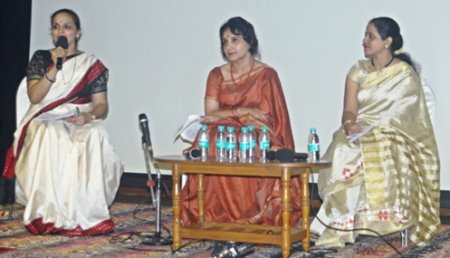 L-R: Medha Divekar, Nutan Patwardhan, Sheetal Kapole 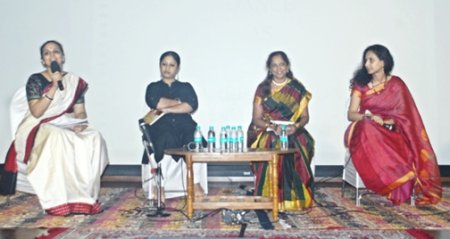 L-R: Medha Divekar, Preeti Valuskar, Nalini Bhavsar, Jonaki Raghavan The last session focused on doing a PhD in dance where Varada Pandit shared her current experiences as a PhD student. Dr. Tina Tambe gave an informative talk on the various steps involved in the degree process right from entrance examinations to thesis submission, while sharing her own experiences while doing her dissertation on ĎDance elements in the poetry of Meera.í The symposium concluded with a powerful talk by Rajashri Shirke, who shared her experience of bringing her research on warkari saints and katha vachan to the stage through her various productions. She emphatically told the audience that they should think of research only if they are deeply passionate about ďshodhĒ or getting a deeper knowledge about a topic and not just to attach the prefix ĎDrí to their name. The Symposium shed light to many untouched, unspoken and doubtful subjects clearing the apprehension and qualms that plagued many over a long period of time. This caucus also brought the Kathak family even closer, giving the artists an opportunity to share their rare expertise. Many more conferences are to be held in future for the amelioration of our treasured art form Kathak. |